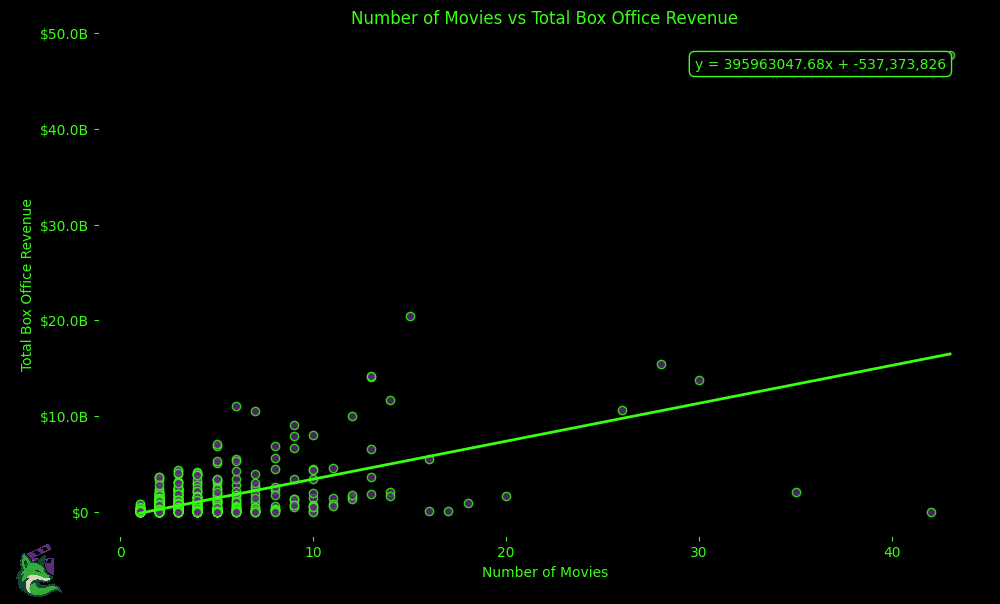Do More Movies Mean More Money For A Movie Franchise?
Executive Summary
This article asks a simple question: do franchises with more movies make more money? Using each franchise’s total box office (worldwide plus inflation-adjusted domestic), we compare earnings against the number of films and fit a straight trend line to summarize the pattern. We explain what the line means in plain terms, highlight big outliers that can skew the result, and discuss why adding movies doesn’t automatically lead to higher box office.
Do More Movies Mean More Money?
Regression of Franchise Size on Total Box Office

What the chart shows:
Each dot is a franchise. The x-axis is the number of movies in the franchise. The y-axis is total box office (worldwide + inflation-adjusted domestic). The green line is a simple linear regression fit.
Interpreting the Regression
Estimated equation:
Total Box Office = 395,963,048 * Movies - 537,373,826
- Slope (~$396M): On average, adding one more movie is associated with about $396 million more total box office across the franchise.
- Intercept (−$537M): A negative starting point isn’t meaningful here (you can’t have a 0-movie franchise). Treat it as a model artifact, not a literal prediction.
Important: This is an estimate, not proof of cause and effect. The line summarizes a trend, but real franchises vary a lot around it.
What the Points Tell Us
- Huge spread at each movie count. Some 6–10 film franchises earn only a few hundred million in total, while others pass $10B+.
- Outliers influence the line. A few mega-franchises at 10–30+ films with very high totals pull the regression upward.
- More movies ≠ guaranteed money. There are franchises with 15–40 entries that earned modest totals compared with smaller, more successful series.
Why More Movies Don’t Always Mean More Money
- Success drives sequels (not always the other way around). Studios make more entries because earlier films performed well—this is reverse causality.
- Quality and appeal vary. Cast, story, reviews, and brand strength differ widely.
- Market factors. Release windows, competition, marketing, and access to big international markets matter.
- Audience fatigue. Later entries can underperform if the formula wears thin.
- Budget risk. Bigger or more frequent releases don’t guarantee bigger returns.
Practical Takeaways
- Expect a positive relationship between franchise size and total earnings, but plan for large uncertainty.
- Decisions should consider per-film averages, trend over time, and international performance, not just the count of movies.
- For forecasting, this simple line can provide a rough baseline, but results will be highly sensitive to outliers and franchise-specific factors.
Data note: Total box office here is worldwide + inflation-adjusted domestic (domestic as defined by the source). The regression is descriptive and should be complemented with deeper analysis (e.g., per-film revenue, time trends, budgets, and genre/IP effects).
Conclusion
While larger franchises generally earn more, the relationship comes with significant uncertainty. Relying solely on the number of films can be misleading it's important to also consider per-film averages, trends over time, and international performance. For forecasting, a simple trend line offers a rough baseline, but outcomes will vary widely depending on outliers and unique franchise dynamics.